1996 PONTIAC GRAND-AM parking brake
[x] Cancel search: parking brakePage 85 of 356
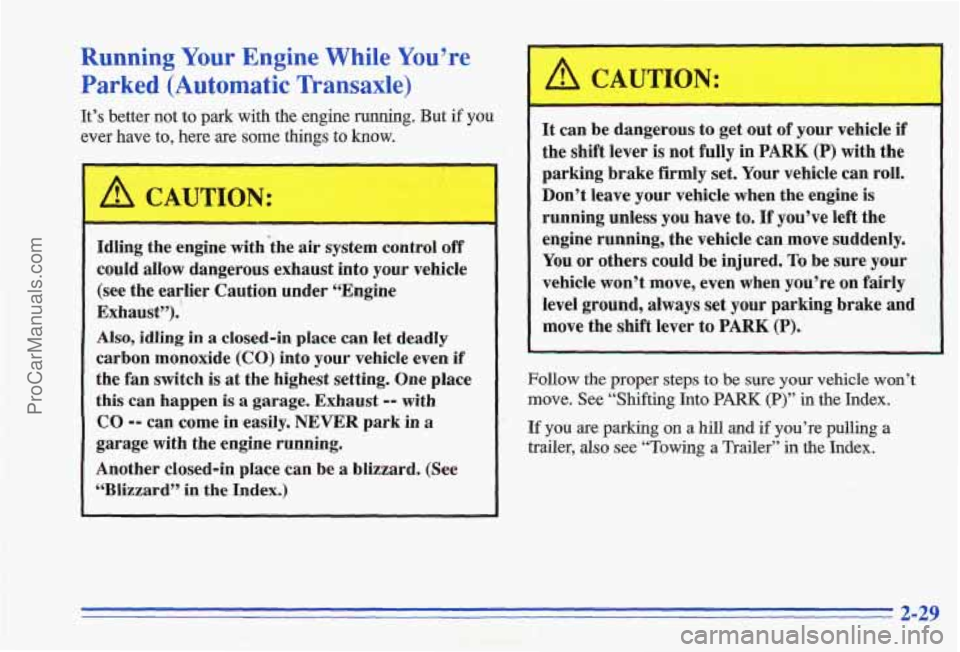
Running Your Engine While You’re
Parked (Automatic Transaxle)
It’s better not to park with the engine running. But if you
ever have to, here are some things to know.
/$ CAUTION:
Idling the engine with the air system control off
could allow dangerous exhaust into your vehicle
(see the earlier Caution under “Engine
Exhaust”).
Also, idling in a closed-in place can let deadly
carbon monoxide
(CO) into your vehicle even if
the fan switch is at the highest setting. One place
this can happen
is a garage. Exhaust -- with
CO -- can come in easily. NEVER park in a
garage with the engine running.
Another closed-in place can be
a blizzard. (See
“Blizzard” in
the Index.)
1
It can be dangerous to get out of your vehicle if
the shift lever
is not fully in PARK (P) with the
parking brake firmly set. Your vehicle can roll.
Don’t leave your vehicle when the engine is
running unless you have to.
If you’ve left the
engine running, the vehicle can move suddenly.
You or others could be injured.
To be sure your
vehicle won’t move, even when you’re on fairly
level ground,
always set your parking brake and
move the shift lever to PARK (P).
Follow the proper steps to be sure your vehicle won’t
move. See “Shifting Into PARK (P)” in the Index.
If you are parking on a hill and if you’re pulling a
trailer? also see “Towing a Trailer” in the Index.
2-29
ProCarManuals.com
Page 96 of 356

Lamps On Reminder
If you open the driver's door while leaving the lamps on
and the ignition off, you will hear a warning chime.
Daytime Running Lamps
Daytime Running Lamps (DRL) caw make it easier for
others to see the front of
your vehicle during the day.
DRL caw be helpful in many different driving
conditions, but they
can be especially helpful in the
short periods after dawn
and before sunset.
The
DRL system will make your high-beam headlamps
come
on at reduced brightness when:
The ignition is on,
, The headlamp switch is OFF,
The light sensor sees daytime light, and
0 The parking brake is released (manual transaxle), or
0 The shift lever is not in PARK (P) or NEUTRAL (N)
When the DRL are on, only your high-beam headlamps
will
be on. The taillmps, sidemarker and other lamps
won't be on. Your instrument panel wonY be lit up
either. (automatic transaxle). When
it's dark enough outside,
your headlamps will
come on at full brightness.
The other lamps that come
on with your headlamps will also come on. A light
sensor ,on top of the instrument panel turns the
headlamps oh and the DRL ,system off. Be sure the light
sensor isn't covered. When it's bright enough outside,
the regular
lamps will go off and your high-bem
headlamps will change
to the reduced brightness of the
DRL.
To idle your vehicle with the DRL off, set the parking
brake on
a manual transaxle or put the vehicle in
PARK (P) or NEUTRAL (N) on an automatic transaxle,
while the ignition is in the OFF or LOCK position. Then
start the vehicle, The DRL will stay off until you release
the
parking brake on a manual transaxle or shift out of
PARK (P) or NEUTaAL (N) on an automatic transaxle.
As with any vehicle,
you should turn on the regular
headlamp system when you need
it.
ProCarManuals.com
Page 113 of 356

Your brake system may not be working properly
if the brake system warning light is on. Driving
with the brake system warning lighlt on can lead
to an accident.
If the light is still on after you’ve
pulled off the road and stopped carefully, have
the vehicle towed
for service.
When the ignition is on, the brake system warning light
will also come
on when you set your parking brake. The
light will stay on if your parlung brake doesn’t release
fully.
If it stays on after your parking brake is fully
released,
it means you have a brake problem.
Anti-Lock Brake System Warning Light
With the anti-lock brake
system,
this light will come
on when you
start your
engine
and it will stay on for
three seconds. That’s normal.
If the light stays on, turn the ignition off. Or, if the light
comes on when you’re driving, stop
as soon as possible
and turn the ignition off. &. 1
Then start the engine again to reset the system. If the .I ‘I
light still stays on, or comes on again while you’re
driving, your Pontiac needs service.
If the regular brake
system warning light isn’t
on, you still have brakes, but
you don’t have anti-lock brakes.
If the regular brake
system warning light is also on, you don’t have anti-lock
brakes and there’s a problem with your regular brakes. See “Brake System Warning Light” earlier
in .this part.
2-57
ProCarManuals.com
Page 114 of 356
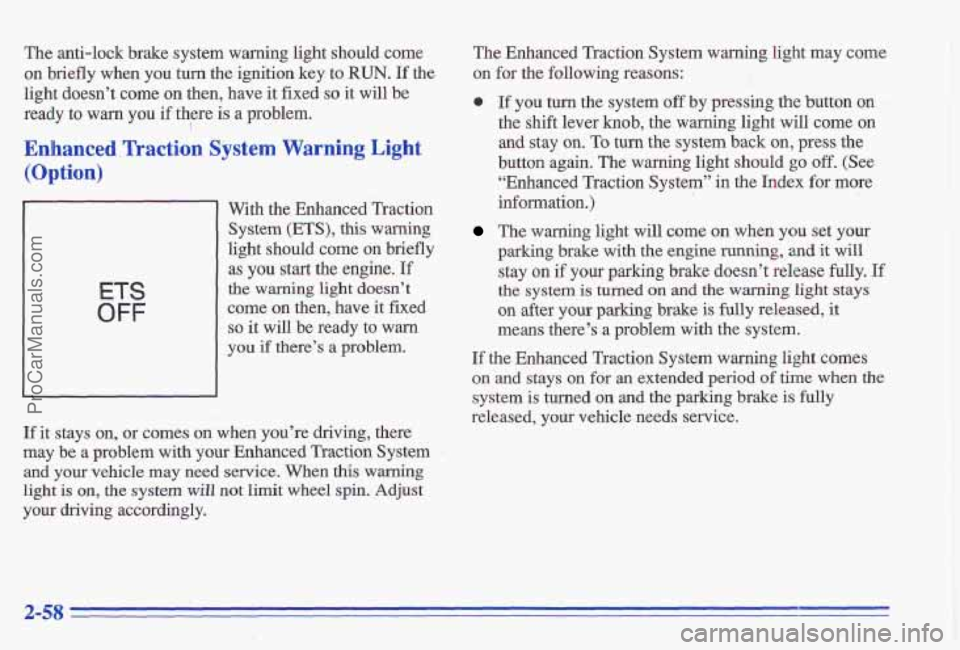
The anti-lock brake system warning light should come
on briefly when
you turn the ignition key to RUN. If the
light doesn’t come
on then, have it fixed so it will be
ready to warn you if there is a problem.
Enhanced,T’raction Syst’em Warning Light
(Option)
!
ETS
OFF
With the Enhanced Traction
System
(ETS), this warning
light should come on briefly
as
you start the engine. If
the warning light doesn’t
come on then, have it fixed
so it will be ready to warn
you if there’s a problem.
If it stays on, or comes on when you’re driving, there
may
be a problem with your Enhanced Traction System
and
your vehicle may need service. When this warning
light is on, the system will not limit wheel spin. Adjust
your driving accordingly. The Enhanced Traction
System warning light may come
on for the following reasons:
0 If you turn the system off by pressing the button on
the shift lever
knob, the warning light will come on
and stay an. To turn the system back on, press the
button
again. The warning light should go off. (See
“Enhanced Traction System” in the Index for more
information.)
The warning light will come on when you set your
parking brake with the engine running,
and it will
stay on if your parking brake doesn’t release fully. If :‘.
the system is turned on and the warning light stays
on after your parking brake is fully released, it
means there’s a problem with the system.
If the Enhanced Traction System warning light comes
on and stays on
for an extended period of time when the
system is turned on and the paking brake is fully
released, your vehicle needs service.
ProCarManuals.com
Page 157 of 356

ETS
OFF
~~~
When this warning light is When the system
is on and
the
parking brake is fully
released, this warning light
will come
on to let you
know if there’s a problem
with the system. See
“Enhanced Traction System
on, the system will not limit
To turn the system on or off,
press the button on the shift
lever knob.
wheel spin. Adjust your driving accordingly. When you turn ‘the system off, the Enhanced Traction
To limit wheel spin, especially in slippery road System warning light will come on and stay on. If the
conditions, you should always leave the Enhanced Enhanced Traction System is limiting wheel spin when
Traction System
on. But YOU Can turn the system Off if . you press the button to turn the system off, the warning
you ever need to. (YOU should turn the system
Off if your
light will come on -_ but the system won’t turn off right
vehicle ever gets stuck in sand, mud, ice or snow. See
away. It will wait until there’s no longer a current need
“Rocking Your Vehicle”
in the Index.) to limit wheel spin.
You can turn the system back on at any time
by pressing
’ the button again. The Enhanced Traction System
warning light should go off.
4-9
ProCarManuals.com
Page 178 of 356
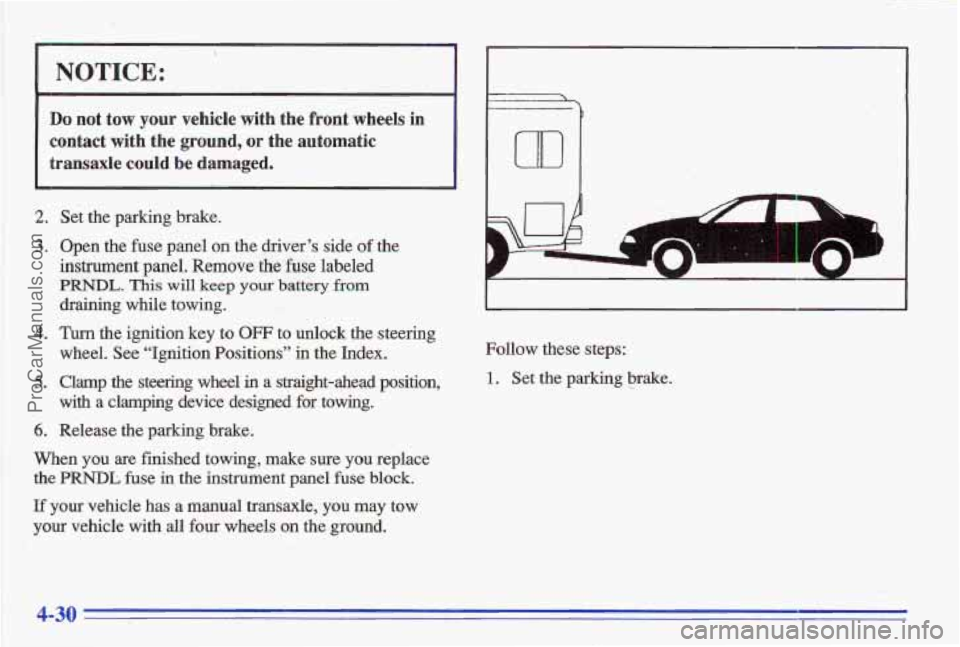
NOTICE:
Do not tow your vehicle with the front wheels in
contact with the
ground, or the automatic
transaxle
could be damaged.
2. Set the parking brake.
3. Open the fuse panel on the driver’s side of the
instrument
panel. Remove the fuse labeled
PRNDL. This will keep your battery from
draining while towing.
wheel. See “Ignition Positions”
in the Index.
with
a clamping device designed for towing.
4. Turn the ignition key to OFF to unlock the steering
5. Clamp the steering wheel in a straight-ahead position,
6. Release the parking brake.
When you are finished towing, make sure you replace
the PRNDL fuse in the instrument panel fuse block.
If your vehicle has a manual transaxle, you may tow
your vehicle with all four wheels on the ground.
m
Follow these steps:
1. Set the parking brake. .
4-30
ProCarManuals.com
Page 179 of 356
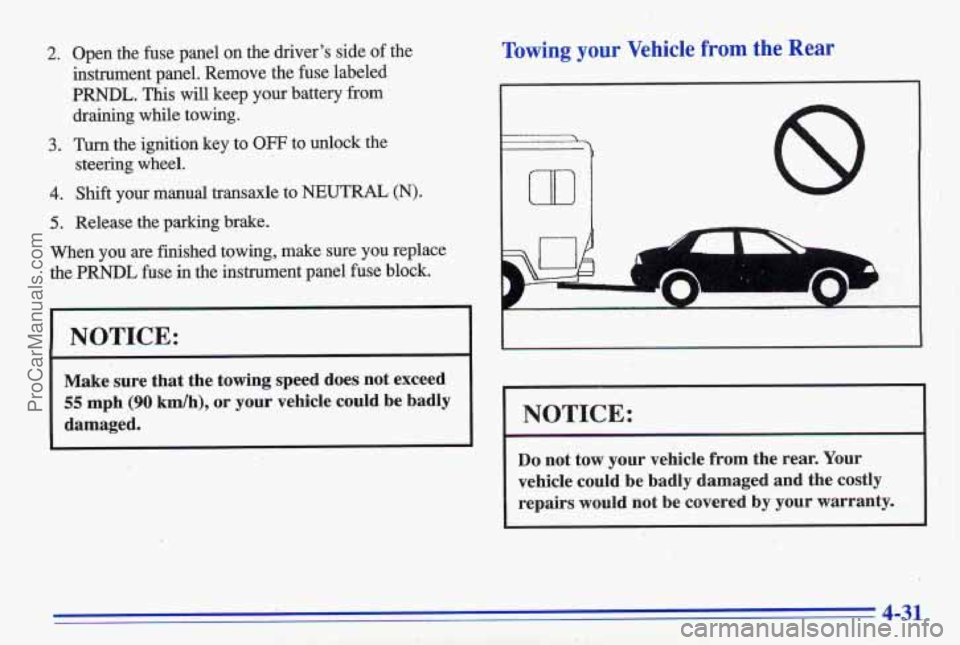
2.
3.
4.
5.
Open the fuse panel on the driver's side of the
instrument panel. Remove the fuse labeled
PRNDL. This will keep your battery from
draining while towing.
Tum the ignition key to OFF to unlock the
steering wheel.
Shift your manual transaxle to
NEUTRAL (N).
Release the parking brake.
When you
are finished towing, make sure you replace
the
PRNDL fuse in the instrument panel fuse block.
NOTICE:
Make sure that the towing speed does not exceed
55 mph (90 kdh), or your vehicle could be badly
damaged.
Towing your Vehicle from the'Rear
'b
8
,NOTICE:
~~ ~
Do not tow your vehicle from the rear. Your
vehicle could be badly damaged and the costly
repairs would not be covered by your warranty.
, .. P 'I
4-31
ProCarManuals.com
Page 187 of 356
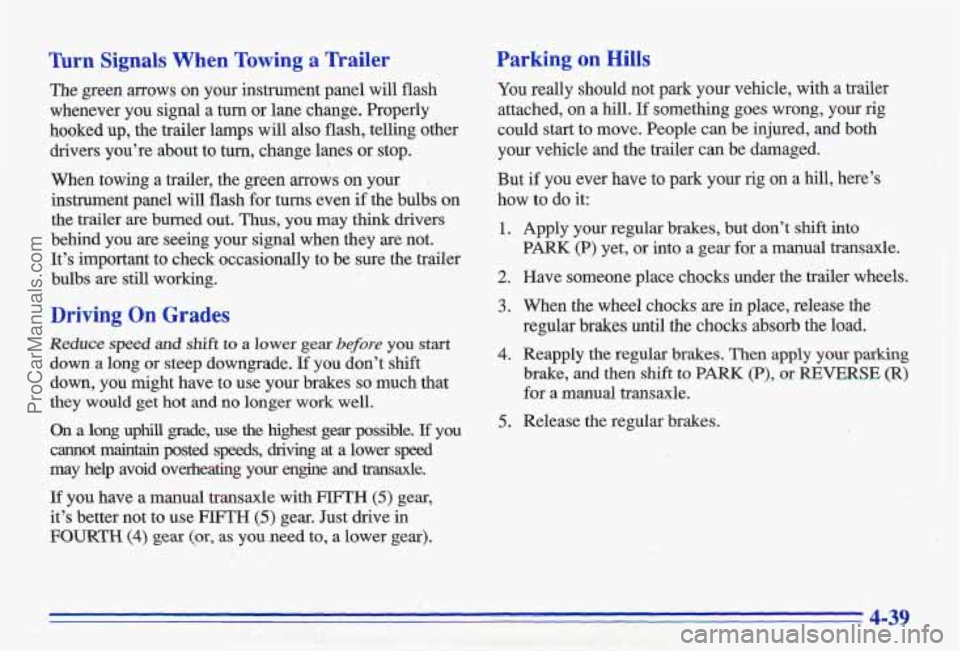
Turn Signals When Towing a Trailer
The green arrows on your instrument panel will flash
whenever you signal a turn or lane change. Properly
hooked up, the trailer lamps
will also flash, telling other
drivers you’re about to
turn, change lanes or stop.
When towing a trailer, the green arrows
on your ’.
instrument panel will flash for turns even if the bulbs on
the trailer are burned out. Thus, you may think drivers
behind you are seeing your signal when they are not.
It’s important to check occasionally to be sure the trailer
bulbs are still working.
Driving On Grades
Reduce speed and shift to a lower gear before you start
down a long or steep downgrade. If you don’t shift
down, you might have to use your brakes
so much that
they would
get hot and no longer work well.
On a long uphill grade, use the highest gear possible. If you
cannot maintain posted speeds, driving at a lower speed
may help avoid overheating your engine and bxmsaxle.
If you have a manual transaxle with FWTH (5) gear,
it’s better not to use
FIFTH (5) gear. Just drive in
FOURTH (4) gear (or- as vou need to, a lower gear).
Parking on Hills
You really should not park your vehicle, with a trailer
attached, on a
hill. If something goes wrong, your rig
could start to move. People can be injured, and both
your vehicle and the trailer can be damaged.
But if you ever have to park your rig on a hill, here’s
how to
do it:
1.
2.
3.
4.
5.
Apply your regular brakes, but don’t shift into
PARK (P) yet, or into a gear for a manual transaxle.
Have someone place chocks under the trailer wheels. When the wheel chocks are in place, release the
regular brakes until the chocks absorb
the load.
Reapply the regular brakes. Then apply your
parking
brake, and then shift to PARK (P), or REVERSE (R)
for a manual transaxle.
Release the regular brakes.
4-39
ProCarManuals.com